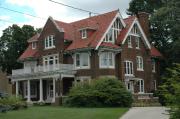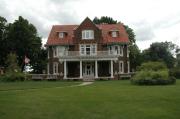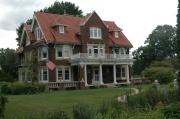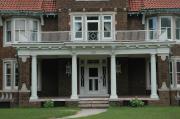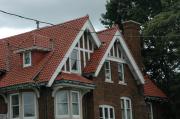Property Record
705 W WISCONSIN AVE
Architecture and History Inventory
| Historic Name: | Charles W. Stribley House |
|---|---|
| Other Name: | |
| Contributing: | |
| Reference Number: | 52222 |
| Location (Address): | 705 W WISCONSIN AVE |
|---|---|
| County: | Outagamie |
| City: | Kaukauna |
| Township/Village: | |
| Unincorporated Community: | |
| Town: | |
| Range: | |
| Direction: | |
| Section: | |
| Quarter Section: | |
| Quarter/Quarter Section: |
| Year Built: | 1910 |
|---|---|
| Additions: | |
| Survey Date: | 1983 |
| Historic Use: | house |
| Architectural Style: | English Revival Styles |
| Structural System: | |
| Wall Material: | Brick |
| Architect: | Van Ryan - Degelleke |
| Other Buildings On Site: | |
| Demolished?: | No |
| Demolished Date: |
| National/State Register Listing Name: | Stribley, Charles W., House |
|---|---|
| National Register Listing Date: | 3/29/1984 |
| State Register Listing Date: | 1/1/1989 |
| National Register Multiple Property Name: | Multiple Resources of Kaukauna |
| Additional Information: | A 'site file' (Kaukauna Historic Properties) exists for this property. It contains additional information such as correspondence, newspaper clippings, or historical information. It is a public record and may be viewed in person at the Wisconsin Historical Society, Division of Historic Preservation-Public History. Fronting the Fox River to the south and facing Wisconsin Avenue to the North, the three-story red brick house, built in 1910, is the largest and most elegant residential structure in Kaukauna. The Milwaukee architectural firm of Van Ryan and DeGelleke designed the house in 1910. A low brick wall (originally a cast iron fence) surrounds a portion of this two acre estate. The carriage house has a tile roof and upper level apartment with fireplace. A fountain with statuary is also located on the grounds. Characterized by its symmetrical composition and central plan, the main house has dormers projecting from the steeplt pitched "barrel tile" roof, brackets beneath the overhanging eaves, a large central chimney, and bay windows on both the first and second floors. The one-story Colonial Revival porch has an upper balcony, Doric columns, and an entablature with dentils. A projecting gable emphasizes this entranceway. Beyond the front door is a vestibule with stained, leaded, and zinc glass panels. A marble threshold - one of many throughout the house - is located between the vestibule and the large reception room. This area has an oak floor and paneling, and an oversized fireplace. Flanking the reception room are four rooms with 12' ceilings: a music room and dining room to the east, and a library and formal parlor to the west. Sliding oak pocket doors are located between the rooms. The formal parlor has a beamed ceiling and an elaborate hand-carved fireplace from Germany (certified as an antique in 1910, thus making it today at least 175 years old). The dining room is paneled in cherrywood and has a cross-beam ceiling. Behind this room are the conservatory with a tile floor, a butler's pantry with original cabinets, and a kitchen which has a picturesque view of the Fox River. Thre are five main rooms (some have cut crystal door knobs) on the second floor. The large master bathroom has a six foot tub, a "sitz" tub, and a shower with an elaborate water system consisting of numerous sprays. This shower is made entirely of marble. The third floor has a large ballroom (now used for storage) as well as two additional bedrooms and a walk-in cedar closet. There are several other uncommon features in this early Twentieth Century house, including a central vacuum system, an intercom telephone line,and closets with automatic lights that turn on when the door is opened. According to the current owner, the original owner, Charles W. Stribley, was able to learn of this innovative electrical feature through his associations with Thomas Edison. Few houses in Kaukauna possess the craftsmanship - or the size - of the former Stribley residence. Its sumptuous interior reflects the gracious lifestyles of both the past and present owners. The antique hand carved German fireplace, zinc and leaded glass, solid marble shower, and advanced electrical and communication systems are just a few of the many unique features. The building is unquestionably the most elegant private residence in the City. Charles W. Stribley was hired as a bookeeper by Oscar Thilmany in 1897, and quickly rose to prominence as an officer of the management team of one of Kaukauna's key industries, the Thilmany Mills. When Mr. Thilmany retired and returned to Germany in 1901, C.W. Stribley became a member of the Board of Directors of Thilmany Pulp and Paper Company and stayed with the company until his death in 1941 as a "production man, a man of great energy and a tireless promoter of new products." Mr. Stribley was also a community "booster" in Kaukauna. For example, he donated the land for the Outagamie County Teachers' College after helping to write the proposal which won the school away from Appleton, the county seat. |
|---|---|
| Bibliographic References: | (A) Kaukauna Tax Assessment Rolls 1898-1919. (B) A History of Thilmany Pulp and Paper Co., 1977, p. 2. (C) Conversation with Mrs. Thomas Zwicker, April 21, 1983. (D) Old Photograph, ca. 1910. (E) Original blueprint drawings. Appleton Post Crescent 2/28/2000. Walking Tour Through Old Kaukauna: Two Self-Guided Historic Tours Kaukauna, Wisconsin, City of Kaukauna, 1983. |
| Wisconsin Architecture and History Inventory, State Historic Preservation Office, Wisconsin Historical Society, Madison, Wisconsin |

